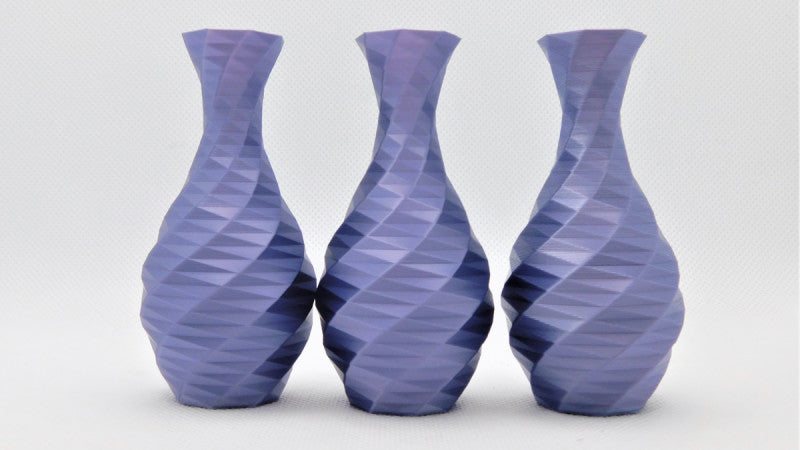Silk PLA filament has gained popularity for its unique shimmering appearance, resembling silk fabric. However, one common challenge associated with silk PLA is its reduced layer adhesion compared to standard PLA filaments. This guide aims to provide detailed advice on successfully printing with silk PLA, emphasizing its specific requirements for temperature, speed, and adhesion management.
Understanding Silk PLA and Its Characteristics
Silk PLA is a variant of PLA filament infused with additives that impart a glossy, silk-like sheen to printed objects. Despite its aesthetic appeal and ease of printing, silk PLA typically exhibits lower layer adhesion, necessitating careful consideration of print settings to achieve durable and visually appealing prints.
- Choosing the Right Print Settings
Printing Temperature: Silk PLA generally requires slightly higher printing temperatures compared to standard PLA. Start with temperatures in the range of 200-230°, adjusting based on your filament manufacturer's recommendations and specific print conditions. Higher temperatures can help improve layer bonding.
Bed Temperature: Maintain a heated print bed temperature between 50-60° to promote initial layer adhesion. Use adhesive aids such as glue stick or hairspray on the print bed surface to enhance adhesion, especially for larger prints or those with a larger footprint.
Print Speed: Due to its unique properties and the need for improved layer adhesion, silk PLA often prints best at slower speeds. Begin with speeds around 30-50 mm/s to ensure each layer has sufficient time to adhere properly before the next layer is added.
Layer Height: Opt for finer layer heights (e.g., 0.1mm or 0.2mm) to maximize surface area contact between layers, which can enhance overall adhesion and structural integrity of the printed object.
- Calibrating Your Printer for Silk PLA
Bed Leveling: Properly level your print bed to ensure consistent first-layer adhesion across the entire build surface. Use a piece of paper or a feeler gauge to achieve the optimal distance between the nozzle and the bed.
Extrusion Calibration: Calibrate your extruder steps/mm to ensure accurate filament extrusion. This calibration is crucial for maintaining consistent layer thickness and improving adhesion between layers.
Flow Rate Adjustment: Adjust the flow rate of filament to optimize extrusion. Balancing the flow rate prevents under-extrusion, which can weaken layer adhesion, and over-extrusion, which can lead to messy prints.
- Enhancing Adhesion Techniques
Build Surface Preparation: Consider using alternative build surfaces like PEI sheets or painter's tape in addition to traditional options such as glass with adhesion aids. Experiment with different surface preparations, such as applying a thin layer of glue stick or lightly coating the bed with hairspray, to find the method that works best for your silk PLA prints.
Raft or Brim Usage: Printing with a raft or a brim can provide additional adhesion and stability, particularly for prints with a larger footprint or those prone to warping. These features increase the surface area contact with the bed and help prevent detachment during printing.
Enclosure Considerations: Utilize a printer enclosure to maintain stable ambient temperatures during printing. Consistent temperatures reduce the risk of warping and improve layer adhesion by minimizing thermal fluctuations that can affect print quality.
- Post-Processing Techniques for Improved Adhesion
Heat Treatment (Annealing): After printing, consider annealing the finished print at a low temperature (around 50-60°) for several hours. Annealing helps to strengthen the printed object and improve layer adhesion by relieving internal stresses within the PLA material.
Resin Coating: Apply a thin coat of resin or a specialized PLA bonding agent to the surface of the print to enhance adhesion between layers and reinforce weak points. This technique is particularly effective for intricate or structurally demanding prints.
- Addressing Common Issues and Troubleshooting
Weak Interlayer Bonding: If layers are separating easily, adjust your print settings, particularly temperature and speed. Increasing temperature slightly and reducing print speed can enhance layer adhesion without compromising print quality.
Warping and Lifting: To mitigate warping, ensure adequate bed adhesion and consider using a brim or raft. Additionally, maintain a stable printing environment by minimizing drafts and temperature variations.
Stringing and Blobbing: Optimize retraction settings and filament cooling to reduce stringing and blobbing issues. Adjusting these parameters helps to maintain clean and precise prints, improving overall layer adhesion and surface finish.
Conclusion
Printing with silk PLA offers a unique opportunity to create visually striking objects with a shimmering finish reminiscent of silk fabric. By understanding the specific requirements of silk PLA filament and implementing the recommended print settings, calibration techniques, and adhesion strategies outlined in this guide, you can achieve high-quality prints with improved layer adhesion and structural integrity. Experimentation and iterative adjustments are essential for mastering silk PLA printing and ensuring consistent success in your 3D printing projects.
